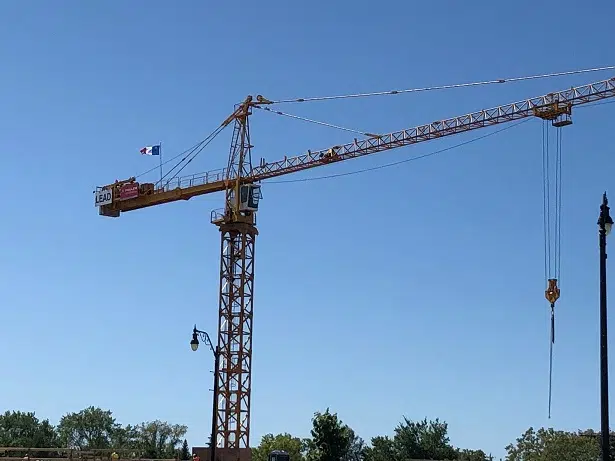
Construction crane in Moncton (91.9 The Bend Photo)
Despite a global pandemic, the City of Moncton ended 2020 with $270.8-million in building permits, surpassing its previous record of $257.4-million in 2019.
Its 10-year average increased by more than $10-million to $202.3-million, surpassing the $200-million mark for the first time. In the last decade, the lowest annual building activity had been in 2014, with $123-million worth of permits filed.
Kevin Silliker, the city’s director of economic development, said last year’s results were “amazing” particularly because it was achieved during a pandemic.
“I think it speaks to the strength and confidence in our economy. It also speaks to the momentum that we have,” he said, adding the multi-residential sector has been a “real highlight.”
“A lot of what we experienced in 2020 was the results of positive momentum that Moncton had built up through 2018 and 2019, and that allowed us to continue our momentum thankfully, into 2020.”
Residential development made up nearly half of the building activity at $133.6-million. That included $90.8-million worth of new apartment buildings representing 728 units.
Four of those buildings, with a total of 248 units, were in the downtown area of Gordon, Weldon and Cameron Streets. They accounted for $37.2-million of permits.
The downtown activity is in line with the City’s plan, following the opening of Avenir Centre in 2018, to hit $108-million worth of new developments in the city’s core by 2023. In late 2018, councillors agreed to expand a financial incentive program for projects worth $10-million and above in the downtown area.
“We have been building a pipeline of potential projects and development prospects well before 2018 and we’ve seen a lot of projects come to fruition. We’ve seen that pipeline grow. And our focus certainly has been on helping drive some of those projects over the finish line,” Silliker said.
As of last summer, the city has reached $90.4-million of that $108-million target. The Junction Urban Village, which entails two mixed-use apartment buildings, a Goodlife gym, and commercial space, is among the projects that were in the pipeline.
Overall, residential building permits increased $42.9-million from the previous year and $85.4 million from 2018.
Silliker said that’s caused by “very, very strong demand,” fueled by the rise in newcomers from other parts of Canada and the world. The remote work trend, which allows people to be “geography neutral,” is among the things facilitating newcomers especially from other parts of Canada who are attracted by the more affordable, closer-to-nature, and less hustle-and-bustle living in Moncton.
“Those individuals have options as far as where they can live, and as long as they can undertake their work, they’re free to move where they wish,” he said. “[Moncton’s] is very appealing to a lot of people that can’t necessarily afford property in other jurisdictions. Or if they’re housebound in another jurisdiction, it’s not appealing either, because they just don’t have as much green space or free space to explore.”
At the same time, supply is low. Moncton’s housing vacancy is at around 2.2 percent, Silliker said.
“The developer community is responding to that demand and creating new residential options,” he said, though he notes that these new developments are still far from being ready and available to rent. Many of the more than 500 units applied for in Q3 2019 is set to hit the market this year.
Despite the boom, there have been concerns about the lack of affordable housing for residents new and old in the city.
Silliker said he doesn’t know what percentage of the new residential developments can be considered affordable. But he noted that affordable housing is a hot topic being discussed at City Hall and that data on affordable and average-rent housing is being gathered.
“There’s definitely trends in the community right now for a lot of newer product. Newer product is generally priced above average,” he explains. “Now, what happens is as the newer product comes online, people maybe want to upgrade and get into a more modern building, so that frees up some older products on the back side of things. So there might be more affordable or average price housing that becomes available.”
Silliker said his team is planning information and sharing sessions about solutions for the shortage of affordable housing with developers and property managers this year.
Institutional development followed with $71.1-million permits, with the largest projects being a $34.1-million K-8 school on McLaughlin Drive and a $25.4-million addition at the Moncton Hospital.
On the other hand, commercial development has been negatively impacted by the pandemic. In 2020, commercial building permits fell by more than half at only $57.8 million last year, from $140.7 million in 2019.
The largest commercial projects are in Moncton’s industrial parks, including a $9.2-million Brandt dealership on Urquhart Ave., and JessEm Tool’s $5.5-million facility on Desbrisay Ave.
Silliker said while offices and other commercial spaces are still being leased, the uncertainty brought about by the pandemic is making developers choose to sit out.
“Obviously this is not the ideal time to be investing or creating new commercial space until there’s more clarity around how the pandemic may impact commercial occupancy or leasing on a medium- or long-term basis,” he said.
He said some believe offices will downsize as more people work from home, while others think that to accommodate social distancing requirements, the workplace might have to stay the same or be larger.
For this year, the residential pipeline is looking “very strong” again, Silliker said, though he expects the commercial sector to remain slow.
Inda Intiar is is a reporter for Huddle, an Acadia Broadcasting partner.




